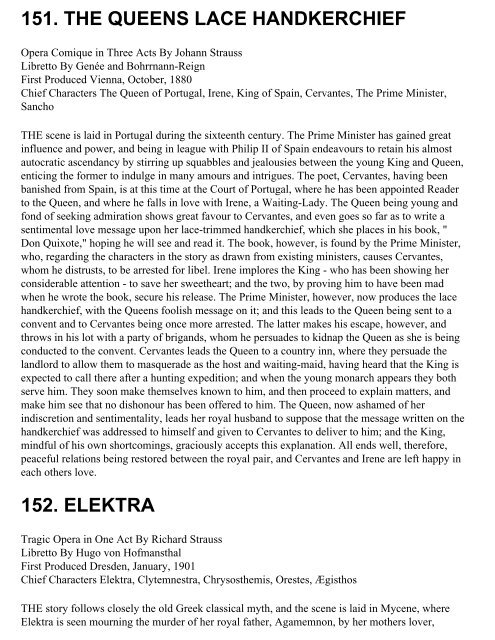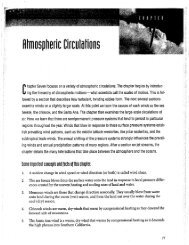Opera Plots I - MDC Faculty Home Pages
Opera Plots I - MDC Faculty Home Pages
Opera Plots I - MDC Faculty Home Pages
Create successful ePaper yourself
Turn your PDF publications into a flip-book with our unique Google optimized e-Paper software.
151. THE QUEENS LACE HANDKERCHIEF<br />
<strong>Opera</strong> Comique in Three Acts By Johann Strauss<br />
Libretto By Genée and Bohrrnann-Reign<br />
First Produced Vienna, October, 1880<br />
Chief Characters The Queen of Portugal, Irene, King of Spain, Cervantes, The Prime Minister,<br />
Sancho<br />
THE scene is laid in Portugal during the sixteenth century. The Prime Minister has gained great<br />
influence and power, and being in league with Philip II of Spain endeavours to retain his almost<br />
autocratic ascendancy by stirring up squabbles and jealousies between the young King and Queen,<br />
enticing the former to indulge in many amours and intrigues. The poet, Cervantes, having been<br />
banished from Spain, is at this time at the Court of Portugal, where he has been appointed Reader<br />
to the Queen, and where he falls in love with Irene, a Waiting-Lady. The Queen being young and<br />
fond of seeking admiration shows great favour to Cervantes, and even goes so far as to write a<br />
sentimental love message upon her lace-trimmed handkerchief, which she places in his book, "<br />
Don Quixote," hoping he will see and read it. The book, however, is found by the Prime Minister,<br />
who, regarding the characters in the story as drawn from existing ministers, causes Cervantes,<br />
whom he distrusts, to be arrested for libel. Irene implores the King - who has been showing her<br />
considerable attention - to save her sweetheart; and the two, by proving him to have been mad<br />
when he wrote the book, secure his release. The Prime Minister, however, now produces the lace<br />
handkerchief, with the Queens foolish message on it; and this leads to the Queen being sent to a<br />
convent and to Cervantes being once more arrested. The latter makes his escape, however, and<br />
throws in his lot with a party of brigands, whom he persuades to kidnap the Queen as she is being<br />
conducted to the convent. Cervantes leads the Queen to a country inn, where they persuade the<br />
landlord to allow them to masquerade as the host and waiting-maid, having heard that the King is<br />
expected to call there after a hunting expedition; and when the young monarch appears they both<br />
serve him. They soon make themselves known to him, and then proceed to explain matters, and<br />
make him see that no dishonour has been offered to him. The Queen, now ashamed of her<br />
indiscretion and sentimentality, leads her royal husband to suppose that the message written on the<br />
handkerchief was addressed to himself and given to Cervantes to deliver to him; and the King,<br />
mindful of his own shortcomings, graciously accepts this explanation. All ends well, therefore,<br />
peaceful relations being restored between the royal pair, and Cervantes and Irene are left happy in<br />
each others love.<br />
152. ELEKTRA<br />
Tragic <strong>Opera</strong> in One Act By Richard Strauss<br />
Libretto By Hugo von Hofmansthal<br />
First Produced Dresden, January, 1901<br />
Chief Characters Elektra, Clytemnestra, Chrysosthemis, Orestes, Ægisthos<br />
THE story follows closely the old Greek classical myth, and the scene is laid in Mycene, where<br />
Elektra is seen mourning the murder of her royal father, Agamemnon, by her mothers lover,













